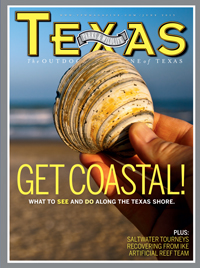
Flora Fact: A Honey of a Wildflower
Fragrant basket-flowers attract a multitude of insects, particularly bees.
By Jason Singhurst
The basket-flower (Centaurea americana), also known as star thistle, is undoubtedly one of the showiest wildflowers in Texas. The name refers to the rigid, straw-colored bracts (special leaves) that sit just below the flower head and resemble an intricately woven basket.
When you encounter a prairie or old field dotted with this white, lavender or brilliant pink member of the sunflower family, take a close look at the insect visitors it attracts. Basket-flower is native to tallgrass and midgrass prairies of the central and southern Midwest as well as Arizona, New Mexico and Mexico. Basket-flowers can also be seen in pastures, woodlands, savannas and roadsides.
During spring and summer of 2012, Texas Parks and Wildlife Department invertebrate biologist Michael Warriner and I conducted several flora and insect surveys of tallgrass prairies in northern and coastal Texas. We encountered bountiful numbers of bumblebees attracted to basket-flowers.
Warriner is an authority on bees, specifically bumblebees, and is documenting the current status of the nine bumblebee species in Texas (www.texasbumblebees.com) with the goal of enlisting citizen “bumble-watchers” to evaluate the state’s bumblebee fauna.

Warriner has learned that bumblebees are major visitors to basket-flowers and prairie ecosystems. In one North Texas prairie, he recorded four species of bumblebees as well as several other solitary bee species.
Basket-flowers grow big and tall. The colorful blooms reach 4 inches in width; the plants grow from 2 to 6 feet tall. The 4-inch-long lance-shaped leaves are rough to the touch. Basket-flowers are annuals, blooming from May through August. Plants favor full sun in mostly well-drained soils.
The blooms of basket-flower attract not only bumblebees but also butterflies and a host of other insects. Many species of birds, including bobwhite quail and sparrows, devour the seeds.
This plant resembles a prickly thistle (Cirsium spp.) but does not have spines. A sweet fragrance makes it desirable as a cut flower for floral arrangements.
The basket-flower is found throughout most of Texas (except deep East Texas) and can be observed at places like McKinney Falls State Park, Bonham State Park, Brazos Bend State Park, Caddo National Grasslands, Cedar Hill State Park, Eisenhower State Park, Granger Wildlife Management Area, Lake Brownwood State Park, LBJ National Grasslands, Lake Somerville State Park and Lake Ray Roberts State Park.
Related stories
Flora Fact: Compass Plant Serves as Prairie Navigator
Flora Fact: Texas Bluebells Are Beautiful and Hardy

